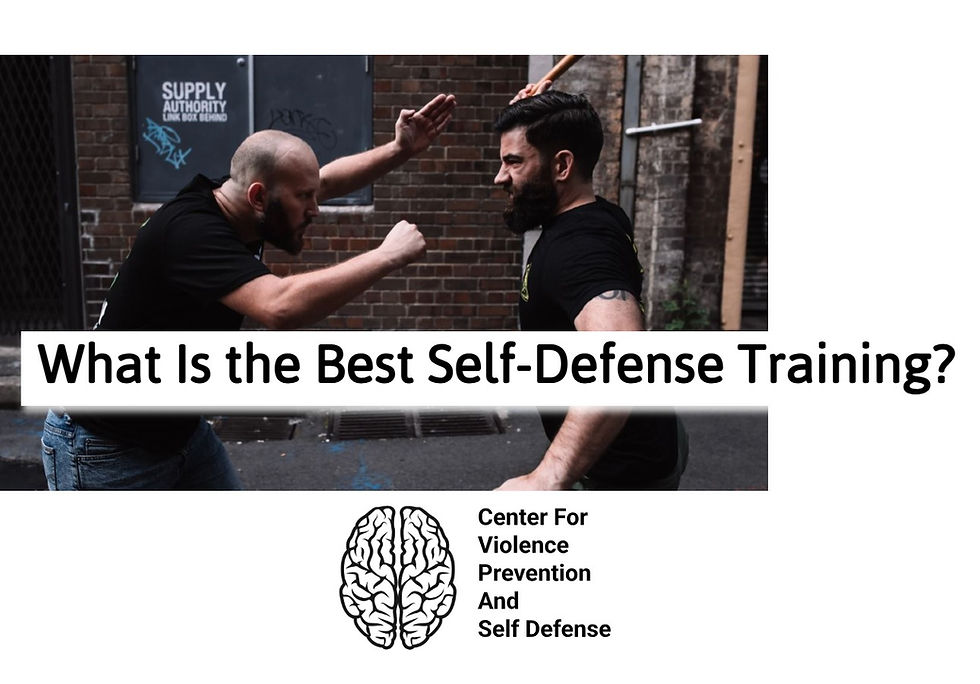What Is the Best Self-Defense Training?
- william demuth

- Jun 23
- 4 min read
Updated: Jun 24
What Is the Best Self-Defense Training?
When it comes to self-defense, there's no one-size-fits-all answer. The best self-defense training depends on your personal goals, physical condition, environment, and even your daily routine. Whether you're seeking confidence, physical fitness, or protection in high-risk situations, understanding what makes a self-defense system effective is key.

What Makes Self-Defense Training Effective?
Before naming specific systems, let’s define what makes a self-defense method worthwhile:
Practicality – Techniques should be realistic and applicable in real-world situations, not just theoretical or sport-based.
Simplicity – Under stress, complex techniques fail. Good training relies on instinctive, easy-to-learn moves.
Situational Awareness – Great self-defense includes avoiding conflict altogether through alertness and prevention.
Pressure Testing – A solid program incorporates real-time sparring or scenario drills to simulate real attacks.
Adaptability – It should be usable for people of various ages, genders, and physical conditions.
Top Self-Defense Systems
1. Krav Maga
Origin: Israel
Focus: Neutralizing threats quickly with aggressive, practical techniques.
Pros: Designed for real-life threats; incorporates gun and knife defense; builds aggression and mental resilience.
Best for: People who want intense, military-style training with real-world application.
2. Brazilian Jiu-Jitsu (BJJ)
Origin: Brazil (adapted from Japanese Jiu-Jitsu and Judo)
Focus: Ground fighting, submissions, and control.
Pros: Effective for smaller individuals against larger opponents; teaches control and de-escalation.
Best for: Those who want to learn self-defense through grappling and submission holds, especially in one-on-one encounters.
3. Muay Thai / Kickboxing
Origin: Thailand
Focus: Powerful striking with punches, kicks, elbows, and knees.
Pros: Excellent for physical conditioning and striking defense; teaches distance control.
Best for: Fitness-oriented individuals looking to combine striking skills with cardio and strength.
4. Boxing
Origin: Global
Focus: Hand strikes, footwork, and head movement.
Pros: Sharpens reflexes, improves confidence, and teaches excellent movement and timing.
Best for: Urban environments where quick punches and evasion can be key.
5. Judo
Origin: Japan
Focus: Throws, takedowns, and leverage-based control.
Pros: Excellent for defense without striking; good for law enforcement or situations requiring restraint.
Best for: People interested in non-lethal, throw-based defense strategies.
6. Mixed Martial Arts (MMA)
Origin: Global
Focus: Combines striking and grappling from various disciplines.
Pros: Broad skill set; trains both stand-up and ground fighting under pressure.
Best for: Those who want a well-rounded, athletic approach to self-defense.
The Importance of Mental Training
The best self-defense training doesn’t stop at physical skills. Mental preparedness — staying calm under pressure, making fast decisions, and recognizing danger signs — is equally important. Many systems now integrate scenario-based training and psychological preparation.
Which One Should You Choose?
Ask yourself:
Do I want to focus on striking, grappling, or both?
Am I training for fitness, confidence, or real-world safety?
Do I need something quick and practical, or do I want to train long-term?
The Value of Training in Both Striking and Grappling
A well-rounded self-defense skill set often includes both striking and grappling. Striking disciplines like boxing or Muay Thai teach you how to manage distance, deliver powerful blows, and defend against punches or kicks—crucial skills in standing altercations.
Grappling arts such as Brazilian Jiu-Jitsu or Judo, on the other hand, prepare you for situations where a fight ends up on the ground or in close quarters.
Spending time in both areas gives you the versatility to handle a wider range of scenarios. Whether you're defending against a sudden punch or escaping from a bear hug, cross-training in both striking and grappling ensures you're prepared wherever the confrontation takes you. Learning basic proficiency in each to build a balanced and effective approach to self-defense.
For beginners seeking quick, street-ready skills, Krav Maga or basic self-defense classes taught by law enforcement may be best. For those interested in deeper martial arts knowledge, BJJ, Muay Thai, or Judo offer structured growth and physical benefits.
Final Thoughts
The best self-defense training is the one you’ll stick with — and that fits your lifestyle, needs, and comfort level. It’s not about being the toughest; it’s about being prepared, aware, and capable. Whether it’s Krav Maga for street defense or Jiu-Jitsu for control and leverage, the right training will empower you not just physically, but mentally.
Remember: The first and best form of self-defense is always awareness. Everything else is just enhancing your ability to act when it counts.
Online Violence Prevention and Self Defense Training Brought To You By Generous Supporters
The Center for Violence Prevention and Self-Defense (CVPSD) is a nonprofit organization dedicated to reducing violence by educating at-risk individuals and communities.
Through a combination of online and in-person training, workshops, and seminars, CVPSD provides practical self-defense skills, violence prevention strategies, risk assessment tools, and guidance on setting personal and relationship boundaries.
Partnering with public and private organizations, schools, nonprofits, community groups, and government agencies—including those under the General Services Administration (GSA)—CVPSD works to empower individuals with the knowledge and skills needed to recognize, avoid, and respond effectively to threats.
.
